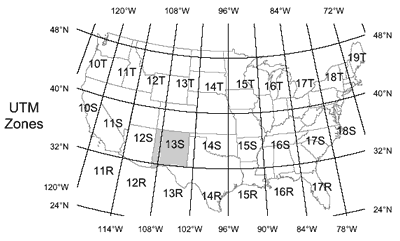
The Global Positioning System
Contents:
GPS Background
The Global Positioning System (GPS) consists of 24 U.S. Department of Defense satellites that send position and time information to portable receivers that use the data to determine their position. There are several websites that explain the GPS system. You might try the FAA GPS site or Peter H. Dana's GPS overview for more information.
GPS has revolutionized earth science by providing accurate 3-D positions for earth features. Some applicaitons include: resolving crustal motions accross faults and between continental plates, greatly improved quality of geologic mapping, and accurate locations of geologic features and samples.
Locating Yourself on a Map
Most 7.5-minute topographic maps represent the spherical earth on paper by utilizing the Universal Transverse Mercator projection that divides the globe into UTM zones (see figure below) If you have a handheld GPS receiver, you may want to locate yourself on your paper map in the field. Latitude/longitude coordinates—because they don't form a rectilinear grid on topographic maps—can be difficult to use without a special rule, and don't convey distances well. A more viable option for determining your position on a map may be using a UTM grid overlay. You can download free grids with the links below, print or copy them onto transparency film, and use them with your paper maps. Be sure to set your GPS to give you UTM coordinates of the proper datum for the map you're using (see below).

If your topographic maps do not have a 1000m grid of lines, it may be necessary to create your own by using a ruler to connect the UTM tics along the map edge. Keep in mind that the closer you are to a UTM zone boundary the more skewed the UTM grid will be relative to true north. Because of this, you should never use the UTM overlay by aligning it on the map's edge or use the UTM grid lines to orient the map with a compass.
UTM Locater Grids (PDF files)
These grids have the top and right axes in reverse order. This makes it easy to plot a position:
- Punch a small hole through the upper-right corner of each grid you want to use.
- Locate the 1-kilometer area of interest on your paper map.
- Position the upper right corner of the overlay grid on the lower left corner of the 1-kilometer area of interest.
- Slide the overlay along the map until the desired UTM Northing and Easting values lie along the bottom and left sides of the 1-km area of interest respectively.
- The punched hole will be at the desired UTM coordinates.
- 1:6000 Locater grid (265 Kb)
- 1:10,000, 1:12:000, 1:24,000, & 1:25,000 Locater grids (one sheet; 253 Kb)
UTM Overlay Grids (PDF files)
These grids extend over several kilometers (for the smaller scales anyway) and are useful for measuring distances as well as locating features. They do not have the reversed axes that the locater grids above do.
- 1:24,000 (402 Kb)
- 1:12,000 (387 Kb)
- 1:10,000 (320 Kb)
- 1:6000 (437 Kb)
- 1:50,000 (130 Kb)
- 1:100,000 (132 Kb)
Map Datums
Using an incorrect map datum is another common pitfall with using a GPS and a topographic map. Most GPS units are set to the World Geodetic System 1984 Datum (WGS 84) by default while the vast majority of topographic maps use the North American Datum of 1927 (NAD 27). Some newer maps in North America use the current official U.S. standard: NAD 1983 (NAD 83) which is, for most practical purposes, virtually identical to WGS 84. The difference between the 1927 and 1983 North American datums can be fairly significant (see DATUM SHIFTS AND DIGITAL MAP COORDINATE DISPLAYS by Larry Moore-USGS); the corner tics of USGS quadrangles printed since 1980 show what the difference on the ground might be:

GPS Software
If you want to convert between lat/long, UTM coordinates, or NAD 27 and NAD 83 datums, you could use GIS software or you might try Corpscon, free software produced by the Army Corps of Engineers. Another useful freeware package is GPS Trackmaker which in addition to performing datum/coordinate trasformations allows your GPS to communicate with your computer. You might also want to visit the National Geodetic Survey's website for more information about datums, geoid models, and software.


